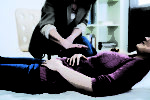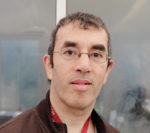
Reiki
 A couple of decades ago, few people had even heard of Reiki whereas today you’ll have certainly seen its name banded about even if you aren’t entirely clear on what it is. Now common in our hospices, Reiki is increasingly available in cancer wards and not on a voluntary basis – it’s actually funded by the NHS in some places and by charities in others.
A couple of decades ago, few people had even heard of Reiki whereas today you’ll have certainly seen its name banded about even if you aren’t entirely clear on what it is. Now common in our hospices, Reiki is increasingly available in cancer wards and not on a voluntary basis – it’s actually funded by the NHS in some places and by charities in others.
Reiki (ray-kee) is a complementary non-invasive health approach in which practitioners place their hands lightly on or just above a person, with the goal of facilitating the individual’s own healing response. It means “universal life energy” in Japanese; its advocates believe that our energy fields affect our physical and spiritual health.
Can it help people with arthritis?
“Reiki is a complementary therapy so it should be used alongside the work that a GP or medical professional is doing,” explains Matt Grogan from the UK Reiki Federation and CNHC registered Reiki practitioner. “Your medical professional remains the principal person in charge of your overall care.
“A Reiki practitioner does not give a medical diagnosis or advice, but instead helps with pain that people are experiencing, whether physical, emotional or mental.”
Research is starting to stack up about the role Reiki can have on anxiety and quality of life. However, there is no large body of evidence highlighting that Reiki can have a hugely positive impact on pain and stiffness experienced by people with arthritis. For the most part, the research simply hasn’t been carried out.
However, there are a few recent studies that suggest Reiki is certainly something to explore. Three studies in Pain Management Nursing highlight that Reiki may have great potential when it comes to reducing pain. An in-depth review of trials published in 2014 concluded that “there is evidence to suggest that Reiki therapy may be effective for pain and anxiety”. And more recently, an analysis of data in 2018 suggests that Reiki is an effective approach to relieving pain. Four studies involving 212 people were analysed with the authors finding that Reiki caused a statistically significant decrease in pain scores.
Therapeutic touch (arguably very similar to Reiki) was found to reduce chronic back pain in a small study in 2019. A total of 29 people with chronic back pain were split into groups; 14 received pain management as recommended by the World Health Organization and the other 15 people received pain management and four therapeutic touch treatments on four consecutive days. Therapeutic touch was found to have “a major effect”, reducing pain levels over the short and long term.
“Chronic pain does not only affect the joints, but the mood, the emotions and general well-being of the client,” Matt says. “So a holistic approach should always be adopted where the practitioner looks at the whole client, their needs, their medication, reason for referral and what they hope to get from the treatment.
“Throughout the process the client and practitioner keep in constant dialogue with one another and will talk about changes in medication, treatment and whether there have been improvements in general well-being.
“Osteoarthritis can make touch painful especially someone laying hands on your shoulders or adding unnecessary pressure. However, Reiki does not have to involve the laying of hands. The practitioner can lay hands a small distance above the client’s body to avoid physical touch to help prevent further discomfort or pain.
“As well as stopping further discomfort, the client may choose to be either seated in a therapy chair or lie on a Reiki bed while having the treatment.”
 What happens in a Reiki session?
What happens in a Reiki session?
Before the session begins the practitioner should give you a full consultation that covers relevant medical and personal history, discussion of the current issue and what your expectations are of the session. You should be asked to complete a consent form. This initial consultation is a discussion between the practitioner and the client, and is where questions can be asked by both sides to alleviate any concerns.
The practitioner will then place their hands lightly on or just above the individual as outlined above. The aim is to instigate a healing response and promote overall wellbeing. There is no massage or manipulation, which is idea for people with arthritis or fibromyalgia.
Sessions can be as short as 30 minutes but most take 60–90 minutes. Depending on the issue or problem some people may need only one session, others benefit from a course and a few enjoy it so much that they attend weekly. And it isn’t hard to learn, so with a little instruction you can give Reiki to yourself.
Cost and choice of practitioner
Unless you can access Reiki though a hospital environment, you’ll have to pay for it yourself and the price varies widely, from £30–£70 an hour depending on where in the country you live and how much training and experience the practitioner has had.
There is currently no single professional organisation regulating Reiki practitioners. And there is no law to say that practitioners need any specific qualifications. Yet it is vital that the person who treats you is properly trained. There are three levels of Reiki practitioners:
- Level 1 means someone can use Reiki to treat family and friends but cannot treat other people or charge money for treatment;
- Level 2 (also called practitioner level) means a person has studied to a higher level and can use Reiki to treat patients;
- Level 3 is a Reiki master or teacher.
Most reputable practitioners belong to a professional association and/or an accredited register such as the CNHC (see below). The CNHC and UK Reiki Federation websites have helpful lists of registered practitioners by region.
The bottom line
Large trials involving many people are needed before Reiki is accepted by the mainstream medical profession, and these trials are unlikely to happen due to lack of funding. Reiki should not be used in place of conventional healthcare but for some people it is a useful approach and it is gaining in popularity. Make sure you carefully check the credentials of practitioners before getting started.
Further information
- Complementary and Natural Healthcare Council, visit cnhc.org.uk or tel 020 3668 0406
- The Reiki Association, visit reikiassociation.org.uk or tel 01892 458708
- The Reiki Connection, visit connect2reiki.co.uk or tel 0117 3779508
- The Reiki Council, visit reikicouncil.org.uk
- UK Reiki Federation, visit reikifed.co.uk or tel 01264 791 441

Melanie Glanville
True story: Melanie Glanville from London
“My first experiences of Reiki was as a client 20 years ago and it wasn’t until many years later that I felt inclined to learn for myself. Reiki has many levels of practice: as a personal wellbeing tool; a ‘folk art’ shared informally with friends and family; or as a treatment received and paid for more formally and delivered by someone fully insured and dedicated to working professionally.
“I have now been a Reiki practitioner in professional practice for about 10 years, working in a south London clinic, from my practice at home in Clapham and at St George’s hospital in Tooting.
“From the start, I have treated myself with Reiki daily to support my own health and well-being, not least of all as it reduces the symptoms I experience personally from pain in my left hip from osteoarthritis. For me, daily self-treatment is an easy ‘go-to’ that acts holistically, benefiting whatever level – physical or spiritual – my life needs help with on that day.
“Five years ago I treated a young woman who had arthritis and polycystic ovaries; her side effects included weight gain and depression. She experienced meaningful improvements in all areas of her life following a number of Reiki treatments and decided to learn Reiki to continue her progress. She attributed her weight loss, mood improvement, frequent relief from pain symptoms and successful completion of a triathlon a couple of years later to stepping onto a journey with Reiki.”
Melanie Glanville is a Reiki practitioner and teacher. Visit www.melanieglanville.co.uk for more information.

Andy Chrysostomou
Andy Chrysostomou from London
“I was diagnosed with severe spondylosis of the spine in 1997, a form of chronic arthritis that was causing narrowing of the vertebrae at the top and bottom of my spine, putting pressure on the nerves causing extreme pain and greatly reduced mobility. My doctor told me he couldn’t believe how bad it was in someone as young as me and there was nothing he could do for me. I was told my condition was degenerative and would worsen with time… eventually I would be crippled. That was actually really scary at the time, particularly as I was sporty, kickboxing and weight training every day.
“I asked for physiotherapy but my doctor told me my condition was too severe. After I persisted he prescribed a series of 10 treatments. He was correct, it did not help. I was prescribed anti-inflammatory painkillers to manage the pain. My doctor told me that I would need to take painkillers for the rest of my life to manage the pain and I must change my lifestyle, no training, carrying shopping bags, excessive walking. I had to ensure I put the minimum stress on my spine. There was nothing else he could offer me.
Discovering Reiki
“Three years later some friends and I saw a presentation by a Reiki teacher. My friend suggested we sign up for the course. I held little hope that it would help my spine problem but after paying the deposit I felt I had to go.
“Straight away, my pain reduced and my mobility improved. I was able to sleep without pain for the first time in years! I used Reiki to treat myself every day and still do. Within a few weeks I was no longer in any pain and was able to live a normal life. I even started training again and now do weights and martial arts.
“By learning Reiki I have been able to treat myself, which allows me to live without pain and to be able to do the things I could do before my spondylosis. I have treated other people with arthritis and it has helped them, but that does not mean it will help everyone. The only way to know is to have one treatment and see what the outcome is. If there is an improvement after one treatment, I believe continued Reiki treatments will help, whether from a therapist or by taking a suitable Reiki course and self-treating.”
Andy Chrysostomou is a Reiki teacher and author of The Essence of Reiki. Visit www.thehealingco.com for more information.
